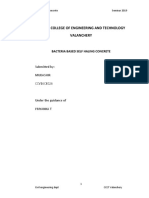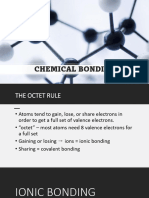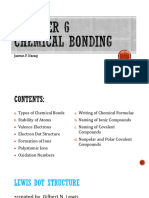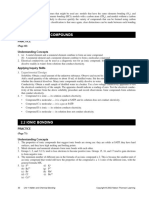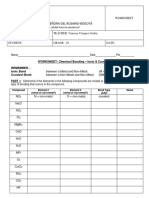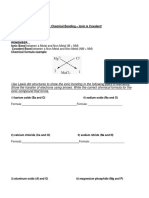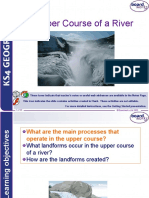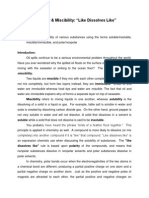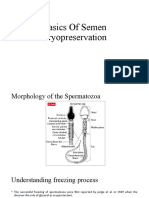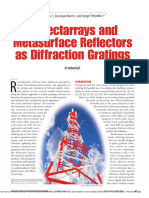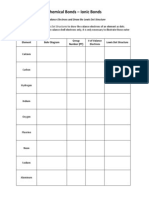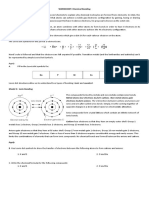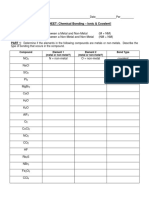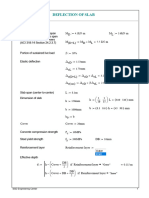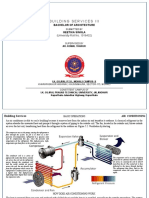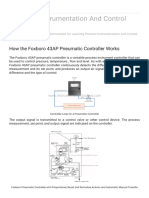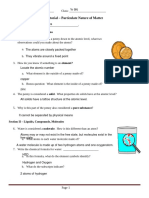Take Home Activity
Uploaded by
chungha simpTake Home Activity
Uploaded by
chungha simpChemistry -- Lewis Dot Structure Practice
Name: ____________________________________________ Date: ____________________
1. Determine the bond type between each of the following atoms.
Mg and P ________________________
Si and O ________________________
H and P ________________________
Cr and F ________________________
2. Complete the following chart.
Element Chemical Total # of # of valence electrons Lewis Dot diagram
Symbol electrons
Potassium
Nitrogen
Carbon
Beryllium
Neon
Sulfur
3. Now try using dot diagrams to predict chemical formulas. Fill in the table below.
Elements Dot diagram for each Dot diagram for Chemical formula
element compound formed
Na and F
Br and Br
Mg and O
4. Draw the electron dot structure for each of the molecules below.
a. NCl3 b. CO2
c. H2S d. SO3
e. CI4 f. NH4+1
g. CH3CH3 h. NH2CH2CHO
WLHS / Conc Chem
Name Date Per
WORKSHEET: Chemical Bonding – Ionic & Covalent!
REMEMBER…
Ionic Bond between a Metal and Non-Metal (M + NM)
Covalent Bond between a Non-Metal and Non-Metal (NM + NM)
PART 1: Determine if the elements in the following compounds are metals or non-metals. Describe the
type of bonding that occurs in the compound.
Compound Element 1 Element 2 Bond Type
(metal or non-metal?) (metal or non-metal?)
NO2 N = non-metal O = non-metal covalent
NaCl
SO2
PI3
MgBr2
CaO
H2O
K2O
AlF3
O2
CuCl2
NO2
CO2
HF
Rb2S
NBr3
Fe2O3
CCl4
PART 2: Use Lewis dot structures to show the ionic bonding in the following pairs of elements. Show the
transfer of electrons using arrows. Write the correct chemical formula for the ionic compound that forms.
1) barium oxide (Ba and O) 4) sodium oxide (Na and O)
Formula: Formula:
2) calcium chloride (Ca and Cl) 5) sodium nitride (Na and N)
Formula: Formula:
3) aluminum oxide (Al and O) 6) magnesium phosphide (Mg and P)
Formula: Formula:
PART 3: Use Lewis dot structures to show the covalent bonding in the following pairs of elements. Once
you have determined the structure for the molecule, write its structural formula in the space provided; use a
dash to represent a shared pair of electrons, and dots to show unshared electrons.
1) nitrogen triiodide (NI3) Final Answer:
Show work here…HINT: nitrogen is in the middle!
2) carbon tetrabromide (CBr4)
Show work here…HINT: carbon is in the middle!
3) dihydrogen monoxide (H2O)
Show work here..HINT: oxygen is in the middle!
You might also like
- WORKSHEET: Chemical Bonding - Ionic & Covalent! Ionic Bond Covalent Bond100% (3)WORKSHEET: Chemical Bonding - Ionic & Covalent! Ionic Bond Covalent Bond3 pages
- Gr10 Tut Learner_s Book Chemical BondingNo ratings yetGr10 Tut Learner_s Book Chemical Bonding21 pages
- SY21 22 SLP - Gr9 W12 D5 Chemistry Review Sheet100% (1)SY21 22 SLP - Gr9 W12 D5 Chemistry Review Sheet4 pages
- Word Drawing or Symbol of The Word: Archdiocesan School of San Fabian, Inc. San Fabian, PangasinanNo ratings yetWord Drawing or Symbol of The Word: Archdiocesan School of San Fabian, Inc. San Fabian, Pangasinan4 pages
- Colegio Nuestra Señora Del Rosario-Bogotá: WORKSHEET: Chemical Bonding - Ionic & Covalent!No ratings yetColegio Nuestra Señora Del Rosario-Bogotá: WORKSHEET: Chemical Bonding - Ionic & Covalent!3 pages
- Technical Bulletin Surface Treatment - EnCRES DUBUIT - 06No ratings yetTechnical Bulletin Surface Treatment - EnCRES DUBUIT - 062 pages
- ACFrOgCdPN - aqtaRkVdRHhGTBRATI 7SlMRD9Q6BlDo8rvC0O yaeTHl sqSBQnXHlxJfTwradqBUpgbpH0eY6xEPH7CsxBRnvt41 S jb9u2jC2KH0E5lGYWo7f9A 4No ratings yetACFrOgCdPN - aqtaRkVdRHhGTBRATI 7SlMRD9Q6BlDo8rvC0O yaeTHl sqSBQnXHlxJfTwradqBUpgbpH0eY6xEPH7CsxBRnvt41 S jb9u2jC2KH0E5lGYWo7f9A 44 pages
- Innovative Solutions To Improved Sound Insulation of CLT FloorsNo ratings yetInnovative Solutions To Improved Sound Insulation of CLT Floors8 pages
- Reflectarrays and Metasurface Reflectors As Diffraction Gratings A TutorialNo ratings yetReflectarrays and Metasurface Reflectors As Diffraction Gratings A Tutorial12 pages
- Physical Science: (Intramolecular Forces)No ratings yetPhysical Science: (Intramolecular Forces)83 pages
- Formative Assessment on Chemical BondingNo ratings yetFormative Assessment on Chemical Bonding1 page
- Unit 2. Chapter 1. Second Law of Thermodynamics SummaryNo ratings yetUnit 2. Chapter 1. Second Law of Thermodynamics Summary5 pages
- Peperiksaan Percubaan Sijil Pelajaran Malaysia 2008: FizikNo ratings yetPeperiksaan Percubaan Sijil Pelajaran Malaysia 2008: Fizik7 pages
- Building Services Iii: Bachelor of Architecture Geetika SinglaNo ratings yetBuilding Services Iii: Bachelor of Architecture Geetika Singla3 pages
- How The Foxboro 43AP Pneumatic Controller Works Learning Instrumentation and Control EngineeringNo ratings yetHow The Foxboro 43AP Pneumatic Controller Works Learning Instrumentation and Control Engineering2 pages
- Three BIG Ideas With Waves: Fill in The Table BelowNo ratings yetThree BIG Ideas With Waves: Fill in The Table Below2 pages
- Aliya Oyelaja - Particulate Nature of Matter WorksheetNo ratings yetAliya Oyelaja - Particulate Nature of Matter Worksheet3 pages
- Chemical Bonding WS Packet Margie Core 2013No ratings yetChemical Bonding WS Packet Margie Core 20134 pages
- Practice Makes Perfect in Chemistry: Compounds, Reactions and Moles with AnswersFrom EverandPractice Makes Perfect in Chemistry: Compounds, Reactions and Moles with Answers3/5 (2)
- Practice Makes Perfect in Chemistry: Compounds, Reactions and MolesFrom EverandPractice Makes Perfect in Chemistry: Compounds, Reactions and MolesNo ratings yet
